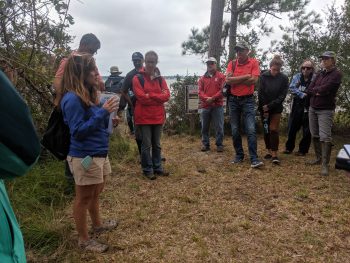On Oct. 8-9, the North Carolina Coastal Federation and Restore America’s Estuaries hosted over 200 professionals in Beaufort for the 2019 Living Shorelines Tech Transfer Workshop. Our dedicated staff was involved with organizing every aspect of the event, from field trips to speakers, and we’re thankful to have such an incredible team lead such an impactful event. The attendees traveled from across the country, and Canada, to share their experience with and interest in implementing living shorelines. The focus on living shorelines stems from the ability of this coastal management method to protect shorelines while providing habitat, pollution filtration and erosion control. The exchange of emerging techniques, regulations and engaging communities has provided a new perspective on how to implement living shorelines, creating climate-resilient methods to protect our coast.

Federation Coastal Scientist Lexia Weaver during one of the field trips
The workshop began with experiential learning, as attendees traveled to successful examples of living shorelines from Pivers Island to Jones Island. For some, this was their first time seeing a living shoreline in person; for others, it was an exciting opportunity to ask coastal scientists about the design and implementation of living shorelines. Beginning with tangible examples of living shoreline successes kicked off this workshop with excitement for how these natural shorelines can be implemented in place of conventional stabilization methods like bulkheads.
Attendees then learned how different stakeholder groups fit into the living shoreline puzzle and what makes people adopt living shorelines. The adoption of this coastal management method has grown however, many challenges remain to make living shorelines more prominent than bulkheads.
Todd Miller, executive director of the Coastal Federation, claimed that “our biggest challenge is getting consumer demand for these projects,” demonstrating these methods have successfully protected shorelines. Even in Maryland, a ‘living shoreline first’ state, barriers to implementation include landowner willingness, contractor knowledge, regulatory debates and decision criteria debates.
Attendees also discussed how permitting is often a challenge. Conventional methods like bulkheads are approved much easier, creating a deterrent to implementing living shorelines. Luckily, a revised general permit was approved earlier this year in North Carolina, enabling living shoreline projects to be approved as easily as hardened structures. Many states have their own general permits in addition to the Nationwide Permit 54 (NWP 54) or place additional conditions on NWP 54 which may impede the process. On the bright side, some state general permits actually expedite the process to implement smaller living shoreline projects.
After a day of learning, attendees exchanged ideas in breakout sessions to discuss the economic, natural science and community aspects of implementing living shorelines. This feverish collaboration uncovered solutions to challenges others are facing and highlighted communication barriers and areas for improvement.
Penny Hooper, a resident of Carteret County, offered solutions to these challenges from a sociological perspective. She stressed the need to reach people about issues they care about and to prioritize doing so for our most vulnerable communities. Penny explained if this message of resilience is going to reach disadvantaged communities, it must be “communicat[ed] through their trusted community resources”. Stakeholders who are not often invited to the table must be included in future discourse to ensure we are reaching those who need resilient protection the most.
Living shorelines are dynamic and therefore resilient, making them extremely desirable to use in place of conventional methods. By engaging with our communities, we can better promote living shorelines as the superior method for protecting our shorelines. As Chris Becraft of Underwood and Associates shared, “the idea of a natural shoreline is always applicable,” highlighting the adaptability and success of these methods to not only protect our coast, but to create a healthy coast.
